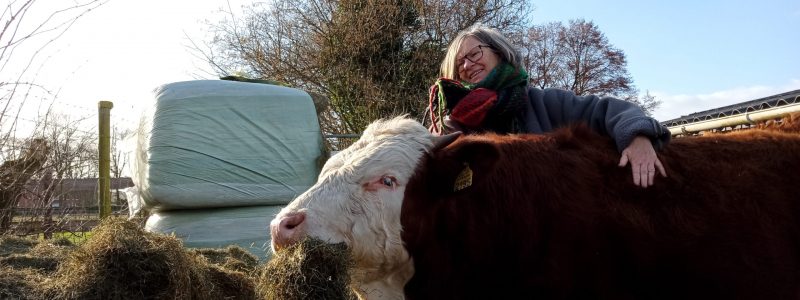Cow and language

The cow is an important symbol of the Dutch landscape, ‘Dutchness’, the Dutch economy and Dutch eating practices. But it is also a controversial symbol; In 2020, more than 2 million cattle were killed in Dutch slaughterhouses, 1.4 million of which were calves younger than nine months. In our imagination we picture cows in the Dutch landscape, but in reality they spend much of their short lives in stalls. As a high-yield animal, the cow has been closely associated with humans for centuries. But what do we know about the cow? How do cows understand each other? How do cows use their voices and body language to communicate with one another and farmers? How do they relate to other cows, other animals and their surroundings?
This project focuses on two questions. First, how do we define what we mean by language? This is a complex question, because there are various linguistic theories that define language. Some try to understand language as a biological system in our brains, others conceive of language as a form of social behaviour. The great majority of linguists exclude the notion that other animals use language; they claim that ‘animal language does not exist’. Human language and human cognitive abilities thus set the standard to be met by other species. Due to this anthropocentric perspective, the languages and cognitive abilities of animals fall short from the start. Second, how do cows relate to their surroundings? Cows actively shape and reshape the landscape, yet the landscape also limits their options. Cows do not live alone, of course; humans and cows form part of a protracted process of domestication. This project investigates the relationship between cows and humans. In what ways do humans relate to cows (as products, as sensitive creatures, as objects)? Which other animals play a role in the relationship with cows?
Due to the rapid fall in biodiversity, growing inequality between humans and other species, the disappearance of habitats for non-human species and overly intensive contact, which has led to the emergence of diseases such as COVID-19, language among animals has become a pressing issue for linguists. This project therefore enriches the concept of language and problematises the notion that language is reserved exclusively for humans. The dairy cow forms the case for the ‘animal languages’ project, which will be carried out in close cooperation with Dutch dairy farmers.
Partners
- Frank van Eerdenburg (Faculty of Veterinary Medicine, Utrecht University)
- Lenny van Erp-Van der Kooij (HAS Den Bosch)
- Sterre Leufkens (Department of Dutch Linguistics, Utrecht University)
- Eva Meijer (Capacity Group Philosophy and Public Affairs, University of Amsterdam)
- Maarten Reesink (Department Media Studies, University of Amsterdam)
- Harry Wels (Department Organisation Science, Vrije Universiteit Amsterdam en African Studies Centre Leiden)
Publications
- Cornips, Leonie, Frank van Eerdenburg, Lenny van Erp, Marjo van Koppen & Bert Theunissen. 2022, te verschijnen. Onze melkkoe, letterlijk en figuurlijk In: Dierzaamheid: Duurzaam samenleven met dieren. Pim Martens, Maarten Reesink & Karen Soeters (red.). Uitgeverij Noordboek | Sterck&DeVreese en Bornmeer.
- Cornips, Leonie. Te verschijnen. Getting to know the dairy cow: an inclusive and self-reflexive sociolinguistics in multispecies emotional encounters. In Language activism and the role of scholars. Cutler, Cecilia, Røyneland & Vrzić, Zvjezdana. Cambridge: Cambridge University press.
- Van Oosten, Eline en Leonie Cornips. Te verschijnen. Goede zorg in de veehouderij: de notie van ‘natuur’ Podium voor Bio-ethiek.
- Cornips Leonie. 2022. The animal turn in postcolonial (socio)linguistics: the interspecies greeting of the dairy cow. Journal of Postcolonial Linguistics 6:210-232.
- Marissa Arts, Anne Janssen, Emma Heeren, Veerle Basten & Leonie Cornips. 2022.
Handvatten voor een veilige ontmoeting met taurossen. Vakblad Natuur Bos Landschap 182: 21-24. - Cornips, Leonie and Louis van den Hengel. 2021. Place-making by cows in an intensive dairy farm: A sociolinguistic approach to nonhuman animal agency. Animals in Our Midst: the challenges of co-existing with animals in the Anthropocene, ed. By Bernice Bovenkerk and Jozef Keulartz, Springer. 177-201.
- De Malsche, Fien and Leonie Cornips 2021. Examining Interspecies Interaction in Light of Discourse Analytic Theory: A Case Study on the Genre of Human-Goat Communication at a Petting Farm. Language and Communication 79: 53-70.
- Cornips, Leonie. 2021. Het stierkalfje dat (er) niet mag zijn. In Nieuwsbrief Diermens Studies. 10 mei 2021. https://www.diermensstudies.nl/nieuws/665969_het-piepkleine-stierkalfje-dat-er-niet-mag-zijn
- Cornips, Leonie. 2021. Column Koeientaal. In: Melkvee. Onafhankelijk vakblad voor de melkveehouder. juni, 20(6):7.
- Cornips, Leonie.2021. Het geadopteerde stierkalfje. Centrum voor Diermens studies, 30 juli 2021. https://www.diermensstudies.nl/nieuws/blog/733303_het-geadopteerde-stierkalfje
- Cornips, Leonie. 2021. #IDFA, Koe Luma. Centrum voor Diermens studies https://www.diermensstudies.nl/nieuws/blog/799897_idfa-koe-luma, 17 december
- Cornips, Leonie 2020. Koeientaal. Vaktaal. Tijdschrift van de Internationale Neerlandistiek 33(1): 4.
- Cornips, Leonie. 2019. The final frontier: non-human animals on the linguistic research agenda. Berns Janine and Elena Tribushinina (eds.) Linguistic in the Netherlands, vol. 36, issue 1, Nov 2019, 13-19. Amsterdam: John Benjamins.
- Video: Do animals speak? 2021. Universiteit Maastricht. https://www.youtube.com/watch?v=S8zZngioOe4&feature=youtu.be
- Leonie Cornips en Marjo van Koppen, ‘Embodied Grammar in Dairy Cows. UiL-OTS Colloquium, Utrecht University, 20 februari 2020 (https://uilotscolloquium.wp.hum.uu.nl/leonie-cornips-marjo-van-koppen/).

